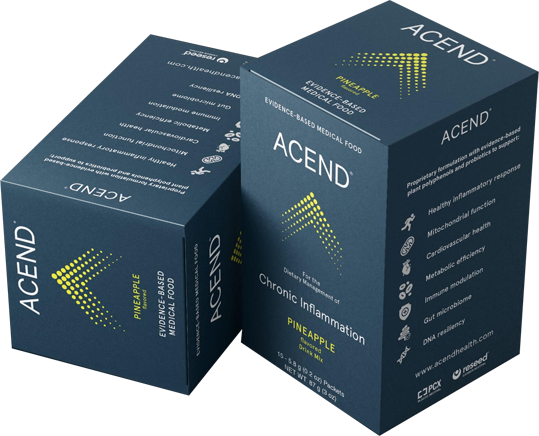The prevalence of diseases associated with chronic inflammation is anticipated to increase persistently for the next 30 years. i
What we make and how does it work?
• ACEND is intended to address the dietary support and management of chronic inflammation caused by viral infection, medical procedures, age related diseased and lifestyle related conditions. Refer to attributes to learn more.
Phytonutrients have been shown in peer reviewed literature to reduce hyper chronic inflammation, support mitochondrial function and act as immune modulators.ii
An 8-week randomized clinical trial was conducted to study the effects of quercetin on glycemic control, oxidative stress, lipid profile, and insulin resistance in T2DM. The results showed that oral quercetin (250 mg/day) for 8 weeks could significantly improve the antioxidant status of patients with T2DM.iii
(-)‐Epicatechin is the most abundant flavanol present in cacao, an exercise mimetic and key ingredient in ACEND. An 8-week clinical study showed (-)-epicatechin to have positive effects on tissue biomarkers indicative of mitochondrial biogenesis, muscle regeneration, and skeletal regeneration.iv
Trimethylglycine (TMG), an amino acid derived from plants, to support proper insulin levels and methylation (essential for DNA production), critical electrolytes and minerals to ensure proper cell function and hydration.
The above are just a few examples. Refer to ingredients to learn more.

Made for dietary management and nutritional support to replace essential nutrients due to:
While coronaviruses target the respiratory tract, they can also affect the gastrointestinal (GI) tract, kidney, central nervous (CNS) and cardiovascular (CV) systems, resulting in organ inflammation and dysfunction especially in immunocompromised patients and the elderly with already existing history of chronic ailments like cancer, CNS disorders, and diabetes.vi,vii
ACEND contains phyto-nutrients demonstrated in studies to address disease related malnutrition which exasperates systemic inflammatory responses that undermine viral host restrictive factors dependent on immune modulation.
Click here to learn about the supporting evidence for the formulation of ACEND and viral infection.
Chemotherapy induces a severe inflammatory response in the body. Peer reviewed literature supports the use of flavonoids found in ACEND for the alleviation of chemotherapy induced inflammatory response and chemotherapy induced peripheral neuropathy (CIPN).viii,ix,x,xi
Click here to learn about the supporting evidence for the formulation of ACEND and CIPN.
Nutritional intervention post medical procedure has been shown to aid in quicker recovery in multiple studies. ACEND contains evidence-based phyto-nutrients that have been shown to aid in the recovery from surgical procedures.xii,xiii,xiv
Gut-dysbiosis is a common side-effect of patients going through chemotherapy and antiviral therapy. ACEND contains phytonutrient compounds, nutrients supporting gut biome, prebiotics and probiotics that support the regulation of inflammatory responses and gut microbiome evisceration that may occur due to chemotherapy and other therapeutic interventions.
Click here to learn about the supporting evidence for the formulation of ACEND and gut-dysbiosis.
Aging causes the accumulation of intracellular damage impairing function, and ultimately leading to age-related diseases.
Recent science is starting to understand the difference between our chronological and biological age. We have designed ACEND to be taken daily to support you in your quest to slow down the biological clock and give your cells and mitochondria the nutrients and fuel they need to optimize your body’s ability to thrive as you age.
When we cannot replace cells cannot be replaced of or repair fix the damage, intracellular damage accumulates, hurting the host cell and surrounding cells, impairing function, and ultimately leading to age-related diseases and aging itself.
The flavonoids in Acend are promising natural dietary molecules to prevent pre-mature aging and aging-related diseases.
Click here to learn about the supporting evidence for the formulation of ACEND and mitochondrial function, senolytics and telomere length.
References
[i] https://www.ncbi.nlm.nih.gov/books/NBK493173/
[ii] https://www.ncbi.nlm.nih.gov/pmc/articles/PMC7037709/
[iii] https://www.ncbi.nlm.nih.gov/pmc/articles/PMC8249127/
[iv] https://www.ncbi.nlm.nih.gov/pmc/articles/PMC7898288/
[v] https://www.ncbi.nlm.nih.gov/pmc/articles/PMC6315948/
[vi] https://www.frontiersin.org/articles/10.3389/fphar.2021.629935/full
[vii] https://www.frontiersin.org/articles/10.3389/fphar.2021.629935/full
[viii] https://www.ncbi.nlm.nih.gov/pmc/articles/PMC8036789/
[ix] https://www.ncbi.nlm.nih.gov/pmc/articles/PMC8008529/
[x] https://www.ncbi.nlm.nih.gov/pmc/articles/PMC8746502/
[xi] https://www.ncbi.nlm.nih.gov/pmc/articles/PMC7979283/
[xii] https://www.ncbi.nlm.nih.gov/pmc/articles/PMC8898378/
[xiii] https://www.ncbi.nlm.nih.gov/pmc/articles/PMC8699565/
[xiv] https://www.ncbi.nlm.nih.gov/pmc/articles/PMC10003005/
[xv] https://www.ncbi.nlm.nih.gov/pmc/articles/PMC6457053/